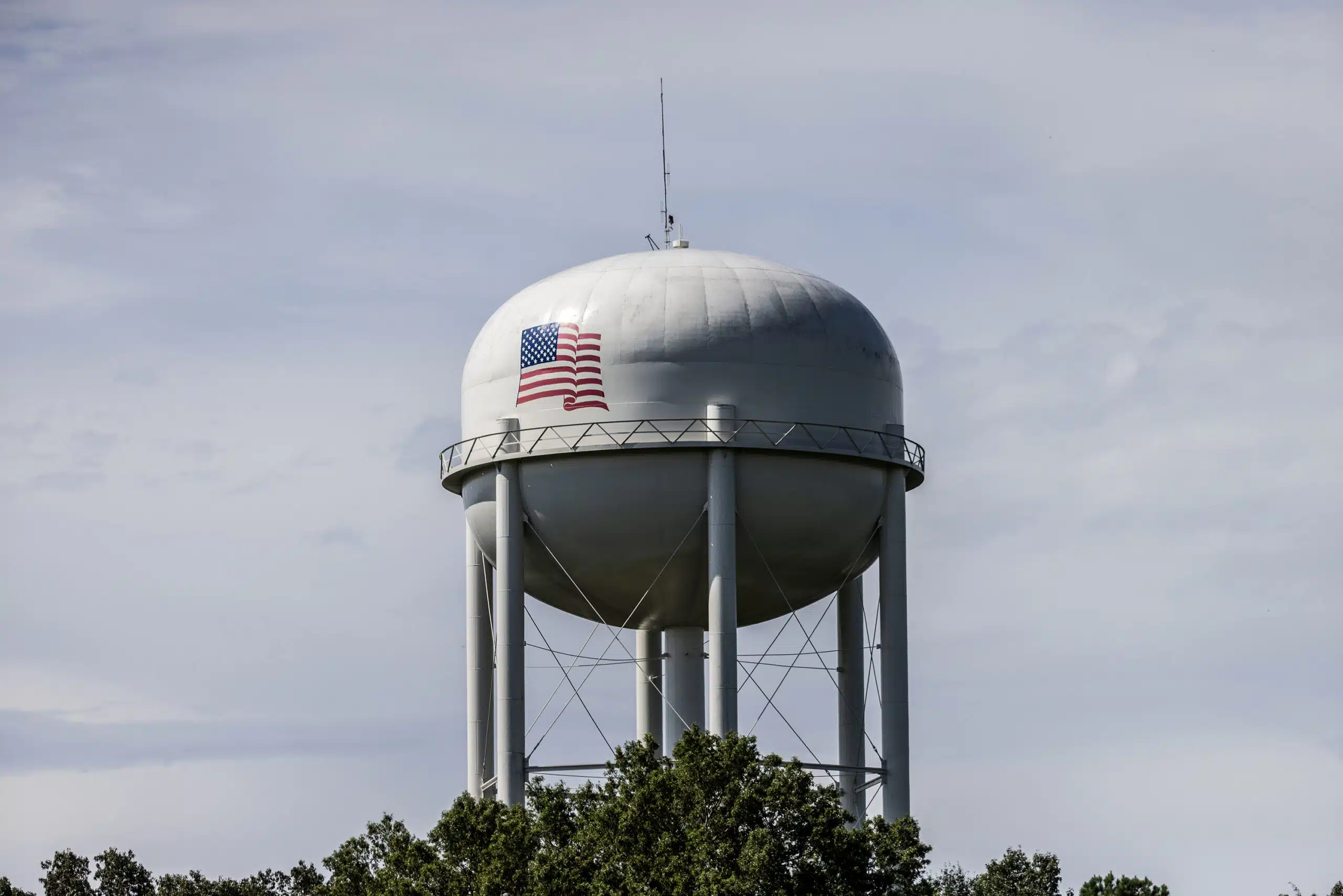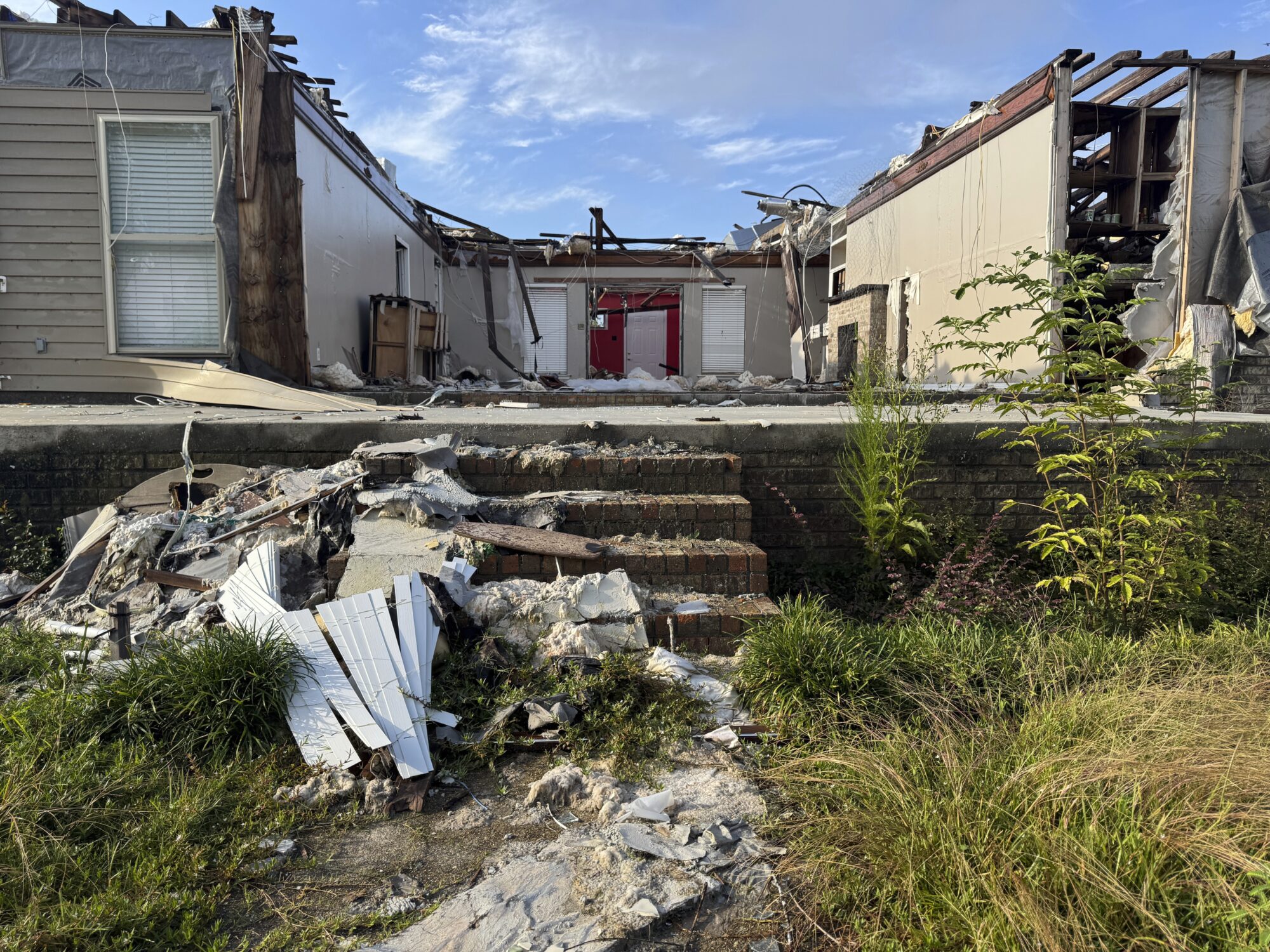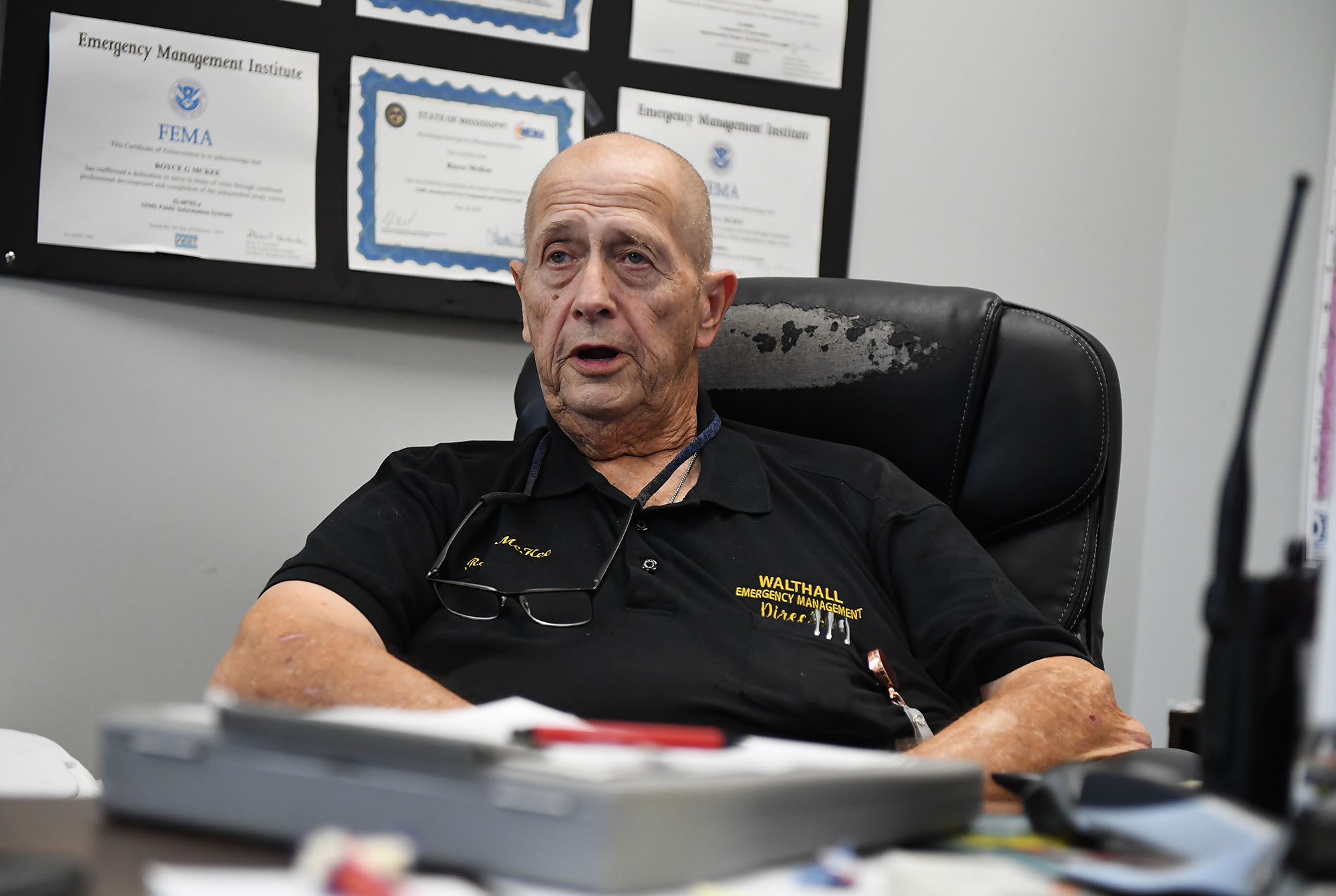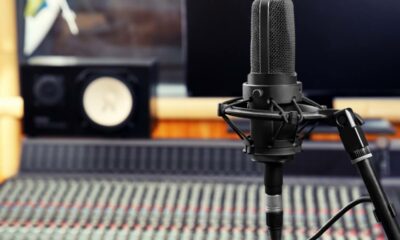Mississippi Today
‘Forever chemicals’ in drinking water are worrying Mississippi residents

If Alabama’s experience foreshadows Mississippi’s future, expect the EPA to find plenty of toxic “forever chemicals” in the drinking water.
A 2022 map shows Alabama with plenty of drinking water exceeding the recommended limit for these chemicals, known as per- and polyfluoroalkyl substances or PFAS. They have been linked to cancer, birth defects, kidney disease, liver problems, decreased immunity, and increased risk of asthma and thyroid issues.
Mississippians remain in the dark about these forever chemicals, however, because the state doesn’t test.
Anna Reade, senior scientist at the National Resource Defense Council, said testing is critical to keeping drinking water safe. “We can’t assume we don’t have exposure to PFAS unless we test,” she said. “Maine found high levels of PFAS in wells that had gone untested for two decades.”
Once hailed for producing items that could resist heat, stains or water, these chemicals are now considered a menace around the globe. Five nations have already agreed to a European ban on PFAS.
Such a ban would cover the thousands of different types of PFAS, which can be found in everything from non-stick cookware to dental floss. The most closely studied PFAS are perfluorooctanoic acid — PFOA — and perfluorooctanesulfonate — PFOS.
Rather than ban all PFAS, the EPA initially put health advisories on those two chemicals at 70 parts per trillion in drinking water, which have since been updated to well under 1 ppt for PFOA and for PFOS. EPA’s newly proposed regulation would limit them to 4 ppt each.
EPA Administrator Michael S. Regan is pushing to reduce current limits because of health problems associated with these chemicals. He said such a change would “prevent thousands of deaths and reduce tens of thousands of serious PFAS-related illnesses.”
A 2020 study suggests up to 200 million Americans are drinking forever chemicals beyond 1 part per trillion — a level that some experts have proposed as a safe limit for drinking water.
Les Herrington, director of Environmental Health for the state Department of Health, discounted the health risks to Mississippians. He pointed to EPA testing in 2013 and 2014, which “all produced results below detection limits and did not indicate potential concerns at that time.”
Recent testing by Consumer Reports, in collaboration with Mississippi Spotlight, however, raises questions about what might have happened since.
Consumer Reports tested 149 drinking municipal and well water samples in Mississippi’s 82 counties. Of those, 146 contained measurable levels of PFAS. Nearly a third of them exceeded EPA’s health advisory for PFOA in drinking water, and almost half exceeded the health advisory for PFOS.

Crystal Dotson, 39, of Corinth and her family saw their drinking water tested at 92.5 ppt in total PFAS, which is far beyond the level of 10 that Consumer Reports recommends. (The EPA has no recommendation on total PFAS, just PFOA and for PFOS.)
She wonders if the forever chemicals have played a role in the declining health of her family since they moved to the city of Corinth a decade ago.
Her 56-year-old husband, Tim, who was in good health, has now developed high blood pressure and polycystic kidney disease. Both hypertension and kidney disease have been linked to these forever chemicals.
Before moving to Corinth, he took blood pressure medicine. Now he’s allergic to that medicine and similar medication.
Their 17-year-old daughter, Stella, is now suffering from two auto-immune diseases, psoriasis and psoriatic arthritis. A series of studies have found exposure to PFAS interfere with immune function.
Their 13-year-old daughter, Veda, had to visit a cardiologist because her heart rate and blood pressure were spiking. “They’re running all kinds of tests,” Dotson said.
She said she believes forever chemicals are playing a role in the decline of her family’s health. “You really feel helpless. Our kids are starting out life sick.”
In 2013, the city of Corinth began to get its drinking water from the Tennessee River via the Tenn-Tom Waterway.
Experts say PFAS can be found at oil refineries, water treatment plants, airports, military sites and a number of industrial sites. From there, the PFAS migrate into streams, landfills or other places before winding up in the soil and drinking water.
Tim believes his family, which also gets their drinking water from the Tennessee River, has been affected. “My brother-in-law has two types of cancer,” he said. “My sister has brain cancer. Everybody in my family has had cancer.”
Many states aren’t waiting for the EPA to act. Bills attacking the PFAS problem have been introduced in 35 states, including Georgia, Florida and Texas, according to Safer States. At least half have taken steps to regulate PFAS in drinking water or expand their monitoring. Mississippi isn’t one of them.
As for Dotson, she isn’t waiting. She plans to talk with the city of Corinth about these PFAS.
Since learning what was in their tap water, the Dotsons have started drinking from store-bought bottles, costing them about $15 a week.

Consumer Reports has identified four water filters, including two pitchers and two under-sink models, that can help consumers filter out forever chemicals.
Some systems, such as reverse osmosis, can cost thousands, which is more than many Mississippians can afford. Even if they can, they might not be able to install such a system, because a third of Mississippians, like the Dotsons, rent their homes.
Crystal hopes the family can convince their landlord to install a reverse osmosis system, she said. “We worry about our children. We want to help them.”
Kelly Hunter Foster, senior attorney for the Waterkeeper Alliance, an environmental advocacy organization, said a more ideal solution would be for states to prohibit the release of PFAS, “rather than try to filter them out on the back end. The public should not have to pay for the pollution that these companies create.”
Mississippi is one of at least 18 states that have sued PFAS manufacturers and distributors, saying they knew “these compounds were toxic” and sold them anyway. The lawsuit, filed in federal court, demands that they pay “to investigate, assess, remediate, monitor, and restore the sites in Mississippi” where PFAS were used. Minnesota settled with one manufacturer, 3M, for $850 million.
Mississippi’s lawsuit identifies these known sites as contaminated: Gulfport Combat Readiness Training Center, Gulfport Naval Construction Battalion Center, Keesler Air Force Base, Columbus Air Force Base, Key Field Air National Guard Base, Jackson Air National Guard Base and Naval Air Station Meridian.
Military bases typically use firefighting foam, which has historically contained PFAs. These forever chemicals can be found in many other places, including fast-food packaging. In a 2022 study, Consumer Reports found PFAS in packaging from every retailer tested.
“Additional investigation and testing will undoubtedly uncover further contamination across the State,” the lawsuit says.
In January 2022, Emmy Morrison and her husband bought their downtown Hattiesburg home.
They found water filters on the faucets because of the lead. She was stunned to find out the bigger problem was PFAS.
Thousands of these forever chemicals exist, but regulators test for only a handful of them.
“Unless you are controlling and testing for all those different types of PFAS, you’re missing major amounts of risk,” said Foster of the Waterkeeper Alliance. “When we look at samples we see some of the highest levels in the rare lesser types of PFAS.”
A decade ago, EPA officials tested for six forever chemicals in 80 of Mississippi’s drinking water systems. This year, they are testing for 29 chemicals in 239 water systems and will release the results here.
Consumer Reports tested for 43 chemicals. That is far short of the thousands of PFAS that exist.
Rather than attack PFAS as a class, the regulatory system in America “is stuck on a toxic treadmill,” said Reade of the National Resource Defense Council. “The EPA has taken a small step in the right direction to get off that treadmill.”
In contrast, the European Union is moving toward phasing out all PFAS, she said. “They’re attacking PFAS at their source. Here, we’re still approving new PFAS.”
The National Resource Defense Council is pushing to reduce “people’s exposure to PFAS,” she said. “We can’t make it zero, but we can definitely reduce their exposure and, therefore, their risk. We need to stop adding to the problem in the first place.”
In Morrison’s home, Consumer Reports found a total of 43.6 PFAS, which is four times more than Consumer Reports’ recommendation of 10.
That concerns the 62-year-old Morrison. “I’m glad I’m not young,” she said.
At least 2,000 people have filed litigation against DuPont, alleging that pollution from the plant has harmed their health, and juries have awarded millions in damages.
In 2005, the EPA uncovered evidence that DuPont had concealed the toxic effects of PFOA, and the company paid a $10.25 million fine, which the agency at the time called the largest environmental administrative penalty in its history.
In 1981, DuPont spotted PFOA in blood samples from pregnant workers in its plant in Washington, West Virginia, and at least one woman had transferred the chemical to her baby, according to the settlement. A decade later, the company learned that the forever chemical was in the public water supply.
DuPont said nothing, and in 2001, the EPA learned of the problem from an attorney working on class-action litigation on behalf of citizens in Ohio and West Virginia who had been affected by the chemical, according to the settlement.
As for House, testing showed total PFAS in her drinking water to be 20.7.
“We’ve got junk in the water,” she said. “I can’t say I’m surprised.”
Before the 74-year-old moved back to her hometown eight years ago, she had a reverse osmosis system for her drinking water in Tampa. Now back on the Mississippi Gulf Coast, she has no such system.
These days, she uses a refrigerator filter on the tap water she drinks. Now she wonders what she needs to do to be safe. “Do I need to bring Perrier from France?” she asked.
She is researching the matter, she said. “I didn’t come this far in life to want to come down with liver cancer.”
This investigation was conducted by Consumer Reports in partnership with Mississippi Spotlight, a collaboration between Mississippi Today, the Clarion Ledger and Mississippi Public Broadcasting.
This article first appeared on Mississippi Today and is republished here under a Creative Commons license.
Mississippi Today
Mississippi prepares for another execution
The Mississippi Supreme Court has set the execution of a man who kidnapped and murdered a 20-year-old community college student in north Mississippi 30 years ago.
Charles Ray Crawford, 59, is set to be executed Oct. 15 at the Mississippi State Penitentiary at Parchman, after multiple requests by the attorney general’s office.
Eight justices joined the majority opinion to set the execution, concluding that Crawford has exhausted all state and federal legal remedies. Mississippi Supreme Court Justice T. Kenneth Griffis Jr. wrote the Friday opinion. Justice David Sullivan did not participate.
However, Kristy Noble with the Mississippi Office of Capital Post-Conviction Counsel released a statement saying it will file another appeal with the U.S. Supreme Court.
“”Mr. Crawford’s inexperienced trial counsel conceded his guilt to the jury — against Mr.
Crawford’s timely and repeated objections,” Noble said in the statement. “Mr. Crawford told his counsel to pursue a not guilty verdict. Counsel did just the opposite, which is precisely what the U.S. Supreme Court says counsel cannot do,” Noble said in the statement.
“A trial like Mr. Crawford’s – one where counsel concedes guilt over his client’s express wishes – is essentially no trial at all.”
Last fall, Crawford’s attorneys asked the court not to set an execution date because he hadn’t exhausted appeal efforts in federal court to challenge a rape conviction that is not tied to his death sentence. In June, the U.S. Supreme Court declined to take up Crawford’s case.
A similar delay occurred a decade ago, when the AG’s office asked the court to reset Crawford’s execution date, but that was denied because efforts to appeal his unrelated rape conviction were still pending.
After each unsuccessful filing, the attorney general’s office asked the Mississippi Supreme Court to set Crawford’s execution date.
On Friday, the court also denied Crawford’s third petition for post-conviction relief and a request for oral argument. It accepted the state’s motion to dismiss the petition. Seven justices concurred and Justice Leslie King concurred in result only. Again, Justice Sullivan did not participate.
Crawford was convicted and sentenced to death in Lafayette County for the 1993 rape and murder of North Mississippi Community College student Kristy Ray.
Days before he was set to go to trial on separate aggravated assault and rape charges, he kidnapped Ray from her parents’ Tippah County home, leaving ransom notes. Crawford took Ray to an abandoned barn where he stabbed her, and his DNA was found on her, indicating he sexually assaulted her, according to court records.
Crawford told police he had blackouts and only remembered parts of the crime, but not killing Ray. Later he admitted “he must of killed her” and led police to Ray’s body, according to court records.
At his 1994 trial he presented an insanity defense, including that he suffered from psychogenic amnesia – periods of time lapse without memory. Medical experts who provided rebuttal testimony said Crawford didn’t have psychogenic amnesia and didn’t show evidence of bipolar illness.
The last person executed in Mississippi was Richard Jordan in June, previously the state’s oldest and longest serving person on death row.
There are 36 people on death row, according to records from the Mississippi Department of Corrections.
Update 9/15/25: This story has been updated to include a response from the Mississippi Office of Capital Post-Conviction Counsel
This article first appeared on Mississippi Today and is republished here under a Creative Commons Attribution-NoDerivatives 4.0 International License.
The post Mississippi prepares for another execution appeared first on mississippitoday.org
Note: The following A.I. based commentary is not part of the original article, reproduced above, but is offered in the hopes that it will promote greater media literacy and critical thinking, by making any potential bias more visible to the reader –Staff Editor.
Political Bias Rating: Centrist
The article presents a factual and balanced account of the legal proceedings surrounding a scheduled execution in Mississippi. It includes perspectives from both the state’s attorney general’s office and the defense counsel, without using emotionally charged language or advocating for a particular political stance. The focus on legal details and court decisions reflects a neutral, informative approach typical of centrist reporting.
Mississippi Today
Presidents are taking longer to declare major natural disasters. For some, the wait is agonizing
TYLERTOWN — As an ominous storm approached Buddy Anthony’s one-story brick home, he took shelter in his new Ford F-250 pickup parked under a nearby carport.
Seconds later, a tornado tore apart Anthony’s home and damaged the truck while lifting it partly in the air. Anthony emerged unhurt. But he had to replace his vehicle with a used truck that became his home while waiting for President Donald Trump to issue a major disaster declaration so that federal money would be freed for individuals reeling from loss. That took weeks.
“You wake up in the truck and look out the windshield and see nothing. That’s hard. That’s hard to swallow,” Anthony said.
Disaster survivors are having to wait longer to get aid from the federal government, according to a new Associated Press analysis of decades of data. On average, it took less than two weeks for a governor’s request for a presidential disaster declaration to be granted in the 1990s and early 2000s. That rose to about three weeks during the past decade under presidents from both major parties. It’s taking more than a month, on average, during Trump’s current term, the AP found.
The delays mean individuals must wait to receive federal aid for daily living expenses, temporary lodging and home repairs. Delays in disaster declarations also can hamper recovery efforts by local officials uncertain whether they will receive federal reimbursement for cleaning up debris and rebuilding infrastructure. The AP collaborated with Mississippi Today and Mississippi Free Press on the effects of these delays for this report.
“The message that I get in the delay, particularly for the individual assistance, is that the federal government has turned its back on its own people,” said Bob Griffin, dean of the College of Emergency Preparedness, Homeland Security and Cybersecurity at the University at Albany in New York. “It’s a fundamental shift in the position of this country.”
The wait for disaster aid has grown as Trump remakes government
The Federal Emergency Management Agency often consults immediately with communities to coordinate their initial disaster response. But direct payments to individuals, nonprofits and local governments must wait for a major disaster declaration from the president, who first must receive a request from a state, territory or tribe. Major disaster declarations are intended only for the most damaging events that are beyond the resources of states and local governments.
Trump has approved more than two dozen major disaster declarations since taking office in January, with an average wait of almost 34 days after a request. That ranged from a one-day turnaround after July’s deadly flash flooding in Texas to a 67-day wait after a request for aid because of a Michigan ice storm. The average wait is up from a 24-day delay during his first term and is nearly four times as long as the average for former Republican President George H.W. Bush, whose term from 1989-1993 coincided with the implementation of a new federal law setting parameters for disaster determinations.
The delays have grown over time, regardless of the party in power. Former Democratic President Joe Biden, in his last year in office, averaged 26 days to declare major disasters — longer than any year under former Democratic President Barack Obama.

FEMA did not respond to the AP’s questions about what factors are contributing to the trend.
Others familiar with FEMA noted that its process for assessing and documenting natural disasters has become more complex over time. Disasters have also become more frequent and intense because of climate change, which is mostly caused by the burning of fuels such as gas, coal and oil.
The wait for disaster declarations has spiked as Trump’s administration undertakes an ambitious makeover of the federal government that has shed thousands of workers and reexamined the role of FEMA. A recently published letter from current and former FEMA employees warned the cuts could become debilitating if faced with a large-enough disaster. The letter also lamented that the Trump administration has stopped maintaining or removed long-term planning tools focused on extreme weather and disasters.
Shortly after taking office, Trump floated the idea of “getting rid” of FEMA, asserting: “It’s very bureaucratic, and it’s very slow.”
FEMA’s acting chief suggested more recently that states should shoulder more responsibility for disaster recovery, though FEMA thus far has continued to cover three-fourths of the costs of public assistance to local governments, as required under federal law. FEMA pays the full cost of its individual assistance.
Former FEMA Administrator Pete Gaynor, who served during Trump’s first term, said the delay in issuing major disaster declarations likely is related to a renewed focus on making sure the federal government isn’t paying for things state and local governments could handle.
“I think they’re probably giving those requests more scrutiny,” Gaynor said. “And I think it’s probably the right thing to do, because I think the (disaster) declaration process has become the ‘easy button’ for states.”
The Associated Press on Monday received a statement from White House spokeswoman Abigail Jackson in response to a question about why it is taking longer to issue major natural disaster declarations:
“President Trump provides a more thorough review of disaster declaration requests than any Administration has before him. Gone are the days of rubber stamping FEMA recommendations – that’s not a bug, that’s a feature. Under prior Administrations, FEMA’s outsized role created a bloated bureaucracy that disincentivized state investment in their own resilience. President Trump is committed to right-sizing the Federal government while empowering state and local governments by enabling them to better understand, plan for, and ultimately address the needs of their citizens. The Trump Administration has expeditiously provided assistance to disasters while ensuring taxpayer dollars are spent wisely to supplement state actions, not replace them.”

In Mississippi, frustration festered during wait for aid
The tornado that struck Anthony’s home in rural Tylertown on March 15 packed winds up to 140 mph. It was part of a powerful system that wrecked homes, businesses and lives across multiple states.
Mississippi’s governor requested a federal disaster declaration on April 1. Trump granted that request 50 days later, on May 21, while approving aid for both individuals and public entities.
On that same day, Trump also approved eight other major disaster declarations for storms, floods or fires in seven other states. In most cases, more than a month had passed since the request and about two months since the date of those disasters.
If a presidential declaration and federal money had come sooner, Anthony said he wouldn’t have needed to spend weeks sleeping in a truck before he could afford to rent the trailer where he is now living. His house was uninsured, Anthony said, and FEMA eventually gave him $30,000.
In nearby Jayess in Lawrence County, Dana Grimes had insurance but not enough to cover the full value of her damaged home. After the eventual federal declaration, Grimes said FEMA provided about $750 for emergency expenses, but she is now waiting for the agency to determine whether she can receive more.

“We couldn’t figure out why the president took so long to help people in this country,” Grimes said. “I just want to tie up strings and move on. But FEMA — I’m still fooling with FEMA.”
Jonathan Young said he gave up on applying for FEMA aid after the Tylertown tornado killed his 7-year-old son and destroyed their home. The process seemed too difficult, and federal officials wanted paperwork he didn’t have, Young said. He made ends meet by working for those cleaning up from the storm.
“It’s a therapy for me,” Young said, “to pick up the debris that took my son away from me.”
Historically, presidential disaster declarations containing individual assistance have been approved more quickly than those providing assistance only to public entities, according to the AP’s analysis. That remains the case under Trump, though declarations for both types are taking longer.
About half the major disaster declarations approved by Trump this year have included individual assistance.
Some people whose homes are damaged turn to shelters hosted by churches or local nonprofit organizations in the initial chaotic days after a disaster. Others stay with friends or family or go to a hotel, if they can afford it.
But some insist on staying in damaged homes, even if they are unsafe, said Chris Smith, who administered FEMA’s individual assistance division under three presidents from 2015-2022. If homes aren’t repaired properly, mold can grow, compounding the recovery challenges.

That’s why it’s critical for FEMA’s individual assistance to get approved quickly — ideally, within two weeks of a disaster, said Smith, who’s now a disaster consultant for governments and companies.
“You want to keep the people where they are living. You want to ensure those communities are going to continue to be viable and recover,” Smith said. “And the earlier that individual assistance can be delivered … the earlier recovery can start.”
In the periods waiting for declarations, the pressure falls on local officials and volunteers to care for victims and distribute supplies.
In Walthall County, where Tylertown is, insurance agent Les Lampton remembered watching the weather news as the first tornado missed his house by just an eighth of a mile. Lampton, who moonlights as a volunteer firefighter, navigated the collapsed trees in his yard and jumped into action. About 45 minutes later, the second tornado hit just a mile away.
“It was just chaos from there on out,” Lampton said.
Walthall County, with a population of about 14,000, hasn’t had a working tornado siren in about 30 years, Lampton said. He added there isn’t a public safe room in the area, although a lot of residents have ones in their home.
Rural areas with limited resources are hit hard by delays in receiving funds through FEMA’s public assistance program, which, unlike individual assistance, only reimburses local entities after their bills are paid. Long waits can stoke uncertainty and lead cost-conscious local officials to pause or scale-back their recovery efforts.

In Walthall County, officials initially spent about $700,000 cleaning up debris, then suspended the cleanup for more than a month because they couldn’t afford to spend more without assurance they would receive federal reimbursement, said county emergency manager Royce McKee. Meanwhile, rubble from splintered trees and shattered homes remained piled along the roadside, creating unsafe obstacles for motorists and habitat for snakes and rodents.
When it received the federal declaration, Walthall County took out a multimillion-dollar loan to pay contractors to resume the cleanup.
“We’re going to pay interest and pay that money back until FEMA pays us,” said Byran Martin, an elected county supervisor. “We’re hopeful that we’ll get some money by the first of the year, but people are telling us that it could be [longer].”
Lampton, who took after his father when he joined the volunteer firefighters 40 years ago, lauded the support of outside groups such as Cajun Navy, Eight Days of Hope, Samaritan’s Purse and others. That’s not to mention the neighbors who brought their own skid steers and power saws to help clear trees and other debris, he added.
“That’s the only thing that got us through this storm, neighbors helping neighbors,” Lampton said. “If we waited on the government, we were going to be in bad shape.”
Lieb reported from Jefferson City, Missouri, and Wildeman from Hartford, Connecticut.
Update 98/25: This story has been updated to include a White House statement released after publication.
This article first appeared on Mississippi Today and is republished here under a Creative Commons Attribution-NoDerivatives 4.0 International License.
The post Presidents are taking longer to declare major natural disasters. For some, the wait is agonizing appeared first on mississippitoday.org
Note: The following A.I. based commentary is not part of the original article, reproduced above, but is offered in the hopes that it will promote greater media literacy and critical thinking, by making any potential bias more visible to the reader –Staff Editor.
Political Bias Rating: Center-Left
This article presents a critical view of the Trump administration’s handling of disaster declarations, highlighting delays and their negative impacts on affected individuals and communities. It emphasizes concerns about government downsizing and reduced federal support, themes often associated with center-left perspectives that favor robust government intervention and social safety nets. However, it also includes statements from Trump administration officials defending their approach, providing some balance. Overall, the tone and framing lean slightly left of center without being overtly partisan.
Mississippi Today
Northeast Mississippi speaker and worm farmer played key role in Coast recovery after Hurricane Katrina
The 20th anniversary of Hurricane Katrina slamming the Mississippi Gulf Coast has come and gone, rightfully garnering considerable media attention.
But still undercovered in the 20th anniversary saga of the storm that made landfall on Aug. 29, 2005, and caused unprecedented destruction is the role that a worm farmer from northeast Mississippi played in helping to revitalize the Coast.
House Speaker Billy McCoy, who died in 2019, was a worm farmer from the Prentiss, not Alcorn County, side of Rienzi — about as far away from the Gulf Coast as one could be in Mississippi.
McCoy grew other crops, but a staple of his operations was worm farming.
Early after the storm, the House speaker made a point of touring the Coast and visiting as many of the House members who lived on the Coast as he could to check on them.
But it was his action in the forum he loved the most — the Mississippi House — that is credited with being key to the Coast’s recovery.
Gov. Haley Barbour had called a special session about a month after the storm to take up multiple issues related to Katrina and the Gulf Coast’s survival and revitalization. The issue that received the most attention was Barbour’s proposal to remove the requirement that the casinos on the Coast be floating in the Mississippi Sound.
Katrina wreaked havoc on the floating casinos, and many operators said they would not rebuild if their casinos had to be in the Gulf waters. That was a crucial issue since the casinos were a major economic engine on the Coast, employing an estimated 30,000 in direct and indirect jobs.
It is difficult to fathom now the controversy surrounding Barbour’s proposal to allow the casinos to locate on land next to the water. Mississippi’s casino industry that was birthed with the early 1990s legislation was still new and controversial.
Various religious groups and others had continued to fight and oppose the casino industry and had made opposition to the expansion of gambling a priority.
Opposition to casinos and expansion of casinos was believed to be especially strong in rural areas, like those found in McCoy’s beloved northeast Mississippi. It was many of those rural areas that were the homes to rural white Democrats — now all but extinct in the Legislature but at the time still a force in the House.
So, voting in favor of casino expansion had the potential of being costly for what was McCoy’s base of power: the rural white Democrats.
Couple that with the fact that the Democratic-controlled House had been at odds with the Republican Barbour on multiple issues ranging from education funding to health care since Barbour was inaugurated in January 2004.
Barbour set records for the number of special sessions called by the governor. Those special sessions often were called to try to force the Democratic-controlled House to pass legislation it killed during the regular session.
The September 2005 special session was Barbour’s fifth of the year. For context, current Gov. Tate Reeves has called four in his nearly six years as governor.
There was little reason to expect McCoy to do Barbour’s bidding and lead the effort in the Legislature to pass his most controversial proposal: expanding casino gambling.
But when Barbour ally Lt. Gov. Amy Tuck, who presided over the Senate, refused to take up the controversial bill, Barbour was forced to turn to McCoy.
The former governor wrote about the circumstances in an essay he penned on the 20th anniversary of Hurricane Katrina for Mississippi Today Ideas.
“The Senate leadership, all Republicans, did not want to go first in passing the onshore casino law,” Barbour wrote. “So, I had to ask Speaker McCoy to allow it to come to the House floor and pass. He realized he should put the Coast and the state’s interests first. He did so, and the bill passed 61-53, with McCoy voting no.
“I will always admire Speaker McCoy, often my nemesis, for his integrity in putting the state first.”
Incidentally, former Rep. Bill Miles of Fulton, also in northeast Mississippi, was tasked by McCoy with counting, not whipping votes, to see if there was enough support in the House to pass the proposal. Not soon before the key vote, Miles said years later, he went to McCoy and told him there were more than enough votes to pass the legislation so he was voting no and broached the idea of the speaker also voting no.
It is likely that McCoy would have voted for the bill if his vote was needed.
Despite his no vote, the Biloxi Sun Herald newspaper ran a large photo of McCoy and hailed the Rienzi worm farmer as a hero for the Mississippi Gulf Coast.
This article first appeared on Mississippi Today and is republished here under a Creative Commons Attribution-NoDerivatives 4.0 International License.
The post Northeast Mississippi speaker and worm farmer played key role in Coast recovery after Hurricane Katrina appeared first on mississippitoday.org
Note: The following A.I. based commentary is not part of the original article, reproduced above, but is offered in the hopes that it will promote greater media literacy and critical thinking, by making any potential bias more visible to the reader –Staff Editor.
Political Bias Rating: Centrist
The article presents a factual and balanced account of the political dynamics surrounding Hurricane Katrina recovery efforts in Mississippi, focusing on bipartisan cooperation between Democratic and Republican leaders. It highlights the complexities of legislative decisions without overtly favoring one party or ideology, reflecting a neutral and informative tone typical of centrist reporting.
-
News from the South - North Carolina News Feed6 days ago
What we know about Charlie Kirk shooting suspect, how he was caught
-
News from the South - North Carolina News Feed6 days ago
Federal hate crime charge sought in Charlotte stabbing | North Carolina
-
Our Mississippi Home5 days ago
Screech Owls – Small but Cute
-
News from the South - Arkansas News Feed6 days ago
NW Arkansas Championship expected to bring money to Rogers
-
News from the South - Louisiana News Feed7 days ago
Haynes wanted in on Wildlife bribery scheme too, informant says
-
News from the South - Alabama News Feed7 days ago
Huntsville Fire & Rescue Holds 9/11 Memorial Service | Sept. 11, 2025 | News 19 at 5 p.m.
-
News from the South - North Carolina News Feed6 days ago
Under pressure, some immigrants are leaving American dreams behind
-
Mississippi News Video6 days ago
Mississippi Science Fest showcases STEAM events, activities












































